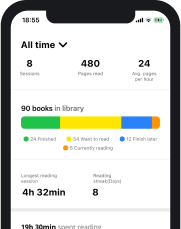While many of us take reading for granted and just go with the flow in terms of reading speed and overall performance, others tend to take things more seriously and work hard on perfecting their technique and improving their efficiency.
Here at Basmo, we support all the different types of readers out there and we constantly dedicate our resources to improving the reading experience for each and every one of you, regardless of age and reading level.
Learning how to stop subvocalizing while reading can play an important role in your general reading experience and performance, so we took the time to find the most important techniques to make the process of learning how to read without subvocalizing as quick and easy as possible.
First, let’s make sure we are all on the same page in regards to the subvocalization meaning.
What is subvocalization in reading?
By its definition, subvocalization is the process of internally speaking while reading, recreating in our mind the sound of every word we read. It is also called silent speech and it is a way for our brains to access the meaning of the content we are reading, comprehend what we read, and even plays a role in remembering the information we go through.
The concept has been studied by scientists since 1868 when it was first taken into consideration as a worthy research topic. A clear experiment on subvocalization has been made only much later, in 1899, when a researcher concluded that subvocalization was the only mental activity that had as effect a considerable movement of the larynx.
Internal speech plays an important role in many of the mental processes we go through every day. It helps us make sense of the things we read, memorize the information we extract, and even plays a role in the encoding and decoding processes our brain has to do every time we read and are required to understand the message.
That being said, subvocalization is not entirely beneficial to the reading process, and we will explore all the benefits and disadvantages of subvocalization while reading below.
Is subvocalization bad?
Generally, no. As I mentioned above, subvocalization plays a very important role in the reading process. Not only is it a natural thing that our brain does involuntarily whenever we do some reading, but it also aids the process of decoding the written text, extracting the information, and retaining it.
Here is why subvocalizing is definitely not a bad habit.
It is a part of the thinking process
Our internal speech is a great part of our thinking process. It is a completely natural process that allows us to form thoughts that make sense. As humans, we find it very difficult to express ourselves in any other way other than through speech. And that speech can be both internal and external. When we talk to other people, we use our ability to speak externally.
When we think about something, more often than not, even without realizing it, we do it through internal speech. This ability to subvocalize is an integral process of all the learning and reading we do, and scientists argue that without it, no learning would be actually possible.
Subvocalization aids the memorization process
Subvocalization has been found to play a role in both short-term memory and long-term memory creation. Our short-term memory, otherwise known as immediate memory, has the ability to use its very limited storage space a lot more effectively for memories that involve subvocalization compared to other sources of information.
For example, it is easier to remember a phone number by subvocalizing it than it is through an image. These phonemic representations of the associated sounds of either letters or numbers are a key ingredient both in our thinking process and memorization of written text.
Subvocalization is a part of comprehension and memory encoding
Memory encoding is a crucial step in the process of acquiring and retaining information. When our brain receives information from the visual receptors (our eyes) through reading, it first recognizes each symbol (letter) and understands how those symbols create words and decodes this thread of letters and words into a message it understands.
This is done by attributing sound to the imagery that it processes. It internally sounds out each word to understand its meaning. This process of attributing sound to imagery is done for both comprehension purposes and memorization. Memories are stored in an encoded state, which is also done through subvocalization.
So, as you can see, subvocalization is an integral part of the reading and learning process, but are there any negatives?
Subvocalization limits your reading speed
The only negative aspect of subvocalization is that it acts as a bottleneck for your reading speed. Not at all surprisingly, the average reading speed for a regular adult is around 200-250 words per minute, while the speaking speed is 200-240 words per minute. And this is not a coincidence by any means.
By subvocalizing while reading, we force our brain to maintain a reading speed that matches the speed we are able to talk at. Speed reading is a complex reading technique that allows us to learn how to increase our reading speed and one of the first things we are required to do is to figure out a way to stop subvocalizing.
How to stop subvocalizing while reading?
Learning how to read without subvocalization is not an easy task. And the first thing we need to make clear right off the bat is that eliminating subvocalization completely from the reading process is impossible. The one thing we can do is to try and reduce it as much as possible if we are interested in increasing our reading speed beyond our speaking speed level.
And another thing we cannot stress enough is how important is to try and reduce subvocalization only if you are in the process of learning to speed read. If that is the case, here are a couple of tips and tricks on how to reduce subvocalization while reading.
Guide your eyes while reading
Using your finger, a pointer, or a ruler, try to keep your eyes constantly on track while reading. Follow the words you are reading with your finger or pointing device. This will allow your eyes to follow the row, and it will help your brain focus more on the visual aspect of the reading rather than subvocalization. In other words, by forcing your eyes to follow your finger and read at the pace you are dictating through your movement, you give your brain less time to try and make sense of the words through subvocalization.
Skim while reading
More often than not, the truly important aspect of reading consists of the information that is being passed on through the text rather than the actual words that you are reading. Teach yourself to skim through the text and find the important information rather than reading entire sentences. This is going to force you to minimize subvocalization, because you are going to be more active with the visual component of reading, looking for the words you know you need rather than reading the entire text as a story. Doing this constantly is going to be great practice for your efforts to reduce subvocalization.
Listen to music
While there are many reasons to listen to music while reading, in the context of reducing internal speech with the purpose of learning to speed read, music can play a crucial role. As long as you figure out a way to listen to music while reading without putting comprehension at risk, music can be a great tool.
That’s because it keeps the parts of the brain that are responsible for processing sound busy. If you constantly have music in your headphones, you will suddenly have a lot less brain power to subvocalize at the same time. That can be a great way of forcing you to reduce internal speech, but it is very important to find a balance between less subvocalization and comprehension loss.
While music can distract you just enough to lose the habit you want to reduce, it can also become too distracting and start affecting how much you understand and memorize while reading. Experiment with different music genres and see which one hits the right spot.
Scan the text before actually reading it
The most common use of subvocalization that actually slows us down while reading happens when we run into unfamiliar words, expressions, or completely unexpected turns of events in the books we read. That is why in order to minimize the use of our internal speech, it is usually a good idea to have a glance at the text and while skimming, check out if any unfamiliar words pop up. This is going to help you tremendously with your reading speed when you do the actual reading.
Practice with Basmo
Reading without subvocalization is not something you are going to learn how to do in just a couple of sessions. It will take a lot of practice, a good mindset, and the use of just the right tools. Luckily for you, our reading tracking app has been designed to meet every possible need of a modern reader.
Here’s how Basmo can help you achieve your goals.
Set goals
It’s always a good idea to have clear goals whenever you want to improve yourself.
While the app doesn’t specifically have the possibility to allow you to set reading goals in terms of speed, it does come with 2 different goal types you can set.
First, you can set a number of minutes you want to spend reading every day so you always make sure to hit your target.
Second, for those of you who like to look at the bigger picture, it allows you to set a goal for the number of books you want to read within a year.
Reading tracking
If you’re interested in eliminating subvocalizing from your reading habits, it means you are also interested in increasing your reading speed. Basmo comes fully packed with features to help you.
Basmo tracks your performance every time you start a reading session, timing it, allowing you to either enter the number of pages you read in that time frame or it can even estimate it based on your past performance.
Thanks to this, you always have access to your reading performance and study your own KPIs like reading speed, pages read, and time spent reading through interesting and comprehensive statistics.
That way, as you start eliminating subvocalizing, you will also be able to track your improvements in terms of reading speed.
Reading schedule
Eliminating subvocalizing will require dedication and effort. And what better way to start this journey than by getting organized?
Here at Basmo, we believe that any effort should be closely managed and organized properly.
That is why our app comes with a built-in scheduler which allows you to select the days of the week you want to do your reading and even different times for each day.
That way, you will have the option to organize your reading sessions according to how your schedule looks for each separate day.
Reading journal
Keep track of your progress by keeping a reading journal within the app. Use this feature to jot down your thoughts on the process of eliminating subvocalizing, write about your achievements and keep a clean record of your evolution.
Final thoughts
While learning how to stop subvocalizing while reading isn’t going to mean that you will ever be able to eliminate subvocalizing completely, it can still have a major impact on your reading speed. Use Basmo to get the much-needed help you deserve on this journey.
Image by pch.vector on Freepik







